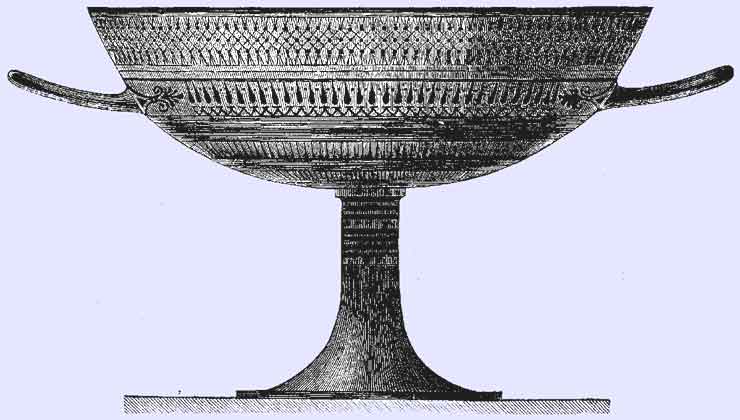.

Weighing of Silphium in the presence of King Arcesilaus II of Cyrene 560-c. 550 BC

Scientific American, Volume 40, No. 13, March 29, 1879
The vase shown in the accompanying engravings must not be classed with ordinary ceramic ware, as it is a veritable work of art. It is the celebrated cup of Arcesilaus, which is preserved in the collection of the library of Richelieu street after having figured in the Durand Museum. It was found at Vulsei, in Etruria. It was made by a potter of Cyrene, the capital of Cyrenaica, founded by Greeks from the island of Thera. It is remarkable that Cyrene, removed from the center of Grecian manufacture, should possess a manufactory of painted vases from which have come so many works of art. The traveler, Paul Lucas, discovered in the necropolis of Cyrene, in 1714, many antique vases, both in the tombs and in the soil. One of them is still preserved in the Museum at Leyden. The Arcesilaus, who is represented on this vase, is not the celebrated skeptical philosopher of that name; it is Arcesilaus, King of Cyrenaica, who was sung by Pindar, and who was vanquished in the Pythian games under the 80th Olympiad (458 years B.C.).
The height of this vase is 25 centimeters, its diameter 28 centimeters. The paste is very fine, of a pale red. It is entirely coated with a black groundwork, which has been generally re-covered with a yellowish white clay, baked on.
According to M. Brongniart, this piece has been subjected to the baking process at least two or three times, thus indicating that the ceramic art had made considerable progress in Cyrene even at that remote epoch.
The following description of this vase is given in the catalogue of the Durand Museum: The King Arcesilaus is seated under a pavilion upon the deck of a ship. His head is covered with a kind of hat with a large brim, and his hair hangs down upon his shoulders. He is clothed in a white tunic and embroidered cloak or mantle, and he carries a scepter in his left hand; under his seat is a leopard, and his right hand he holds toward a young man, who makes the same gesture, and he is weighing in a large scale assafœtida, which is being let down into the hold of the ship. We know that he deals with assafœtida because one of the personages (the one who lifts up his arm toward the beam of the scale) holds in his right hand something resembling that which is in the scale, and the Greek word traced near it signifies "that which prepares silphium." Assafœtida, the resinous matter of the silphium, is used largely by the Greeks in the preparation of their food. The Orientals to-day make frequent use of it and call it the delight of the gods; while in Europe, because of its repulsive odor, it has long been designated as stircus diaboli.
| Ancient Greece
Science, Technology , Medicine , Warfare, , Biographies , Life , Cities/Places/Maps , Arts , Literature , Philosophy ,Olympics, Mythology , History , Images Medieval Greece / Byzantine Empire Science, Technology, Arts, , Warfare , Literature, Biographies, Icons, History Modern Greece Cities, Islands, Regions, Fauna/Flora ,Biographies , History , Warfare, Science/Technology, Literature, Music , Arts , Film/Actors , Sport , Fashion --- |
Retrieved from "http://en.wikipedia.org/"
All text is available under the terms of the GNU Free Documentation License

